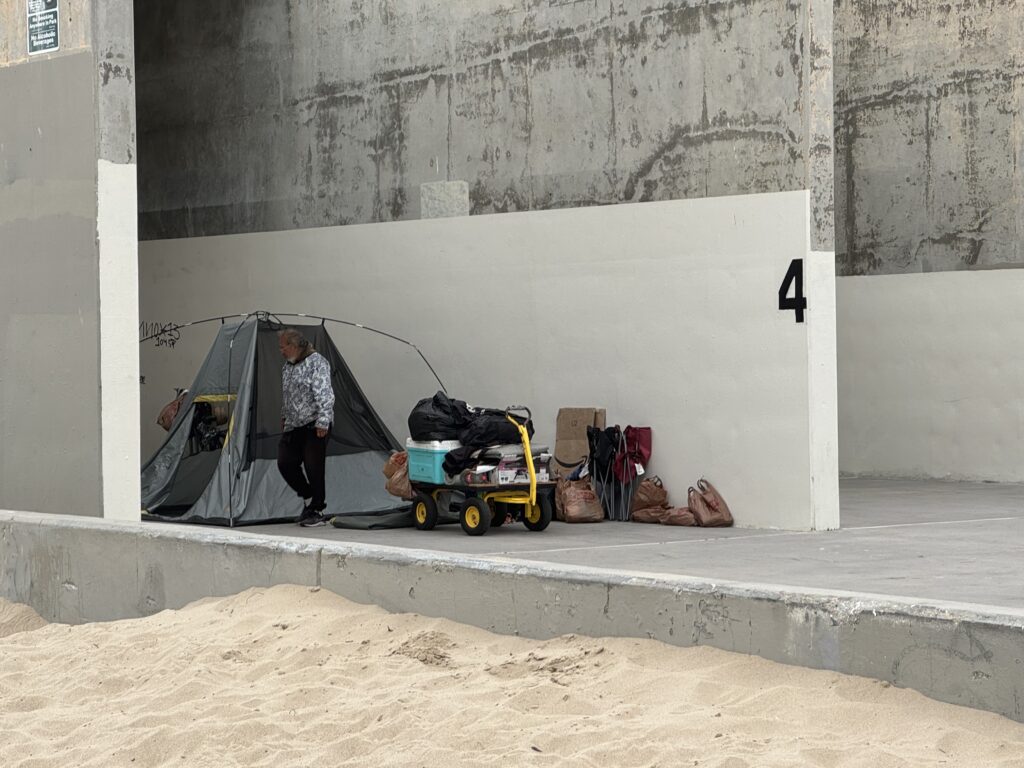Another dead body in Venice, a life wasted. The statistics in Los Angeles are overwhelming. Seven people die per day on the streets.
The paramedics had responded and had sent someone back to the vehicle to get a sheet, when this editor went by on the bike path at 9:10 a.m.
“Is the coroner coming?” I asked.
“Yes,” was the response.
“Drug overdose?” I asked.
“Likely, don’t know,” was the response. Then a medic returned, and the man was covered. As I rode off, a police car with lights flashing was coming down the sidewalk to reach the public bathrooms location.
“Leaving people on the street affects everyone – small businesses, residents and the Angelenos who live in RVs and tents,” Mayor Karen Bass said in an April 23 press release.
She notes that since the beginning of this year, more than 350 Angelenos have been moved inside through Inside Safe. But if seven people per day are dying on the streets, that means that 791 have died in that same time period – including this man, since the beginning of the year.
“Ensuring folks have access to housing is key to building strong communities,” Councilmember Ysabel Jurado said in the release. “Inside Safe is an important piece of that puzzle connecting Angelenos experiencing homelessness with housing and supportive services.”
But does putting people inside apartments help the drug- and alcohol-use problems and the mental health issues? Housing does not include 24/7 support services.
Even though Los Angeles is projecting an $8 billion deficit, Bass is doubling down on money spent on homeless programs. In the proposed 2025-26 budget, $900 million will be spent on homelessness, of which $100 million will go to Inside Safe.
The City Council has now asked for an analysis of homelessness spending and a creation of a public database of homeless-related programs click here.
The analysis would examine spending under Inside Safe, LAHSA contracts, safe parking, and street medicine teams.
Having worked as volunteer with the Pacific Palisades Task Force on Homelessness, this editor watched social workers and volunteers offer services to the homeless, which are often turned down. The people with drug issues generally do not want services. The mentally ill don’t recognize they need services. And of course there are the few with warrants, eluding the police.
Here’s the crux of the matter. Mayor Bass means well. If the people on the streets wanted apartments they could get them. They exist. This is not really about housing.
I watched people in Pacific Palisades scramble once the January 7 Fire destroyed homes – more than 25,000 were homeless in a day.
Those people contacted relatives and friends and slept on sofas, they maxed out credit cards to stay in hotels – and FEMA helped those who asked. Some had a second home, but the majority did not.
The Westside Current did an investigation in September and found that 1,200 city-owned permanent housing units were vacant. (“After spending $550 Million, Over 70 Percent of Los Angeles County Project Homekey Homeless Rooms Vacant”) click here.
The investigation focused on properties acquired through Project Homekey, a state-funded initiative to convert hotels and motels into permanent supportive housing. Of the 2,157 rooms purchased by Los Angeles County, over 71% remain unoccupied years after acquisition. Notable examples include the 57-room former Motel 6 in Harbor City ($7.9 million), the 107-room Extended Stay in Carson ($41.8 million), and the 109-room Grand Park Inn in Baldwin Park ($42.8 million).
Housing is available.
In the past two fiscal years, the city has spent a combined total of $1.28 billion on homelessness.
It might be time to change the focus from housing to mental-health help and aid for substance abuse. This year another $100 million will be used for Inside Safe to save 1,400 homeless people – while another 2,555 people die on the street.



Just another day is “paradise”. LOL